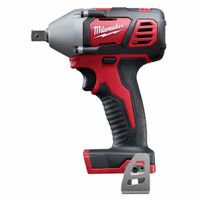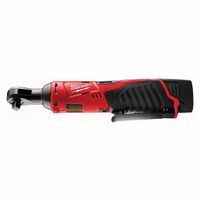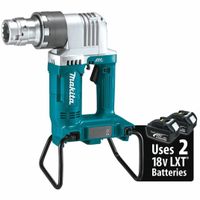Call +(254) 703 030 000 / 751 483 999 / 721 704 777
- Home
- Tools
- Power Tools
- Impact Wrenches Power Torque Wrenches Power Ratchets
.....Read More
Frequently Asked Questions
What is the difference between an impact wrench and a power torque wrench?
An impact wrench and a power torque wrench are both tools used for tightening and loosening fasteners, but they operate differently and are suited for different applications.
An impact wrench is a power tool that delivers high torque output with minimal exertion by the user. It uses a hammering mechanism to deliver strong, sudden rotational and downward force, making it ideal for loosening stubborn or rusted bolts and nuts. Impact wrenches are commonly used in automotive repair, heavy equipment maintenance, and construction. They are available in various power sources, including pneumatic (air-powered), electric, and battery-operated models. The key feature of an impact wrench is its ability to deliver high torque quickly, but it lacks precision in torque control.
A power torque wrench, on the other hand, is designed to apply a specific amount of torque to a fastener. It is used when precise torque settings are critical, such as in mechanical and structural applications where over-tightening or under-tightening can lead to equipment failure or safety hazards. Power torque wrenches can be manual, electric, or hydraulic, and they often come with digital displays or settings to ensure accuracy. Unlike impact wrenches, power torque wrenches do not use a hammering action; instead, they apply a steady, controlled force to achieve the desired torque.
In summary, the main difference lies in their function and application: impact wrenches are used for high-torque, quick applications without precision, while power torque wrenches are used for precise torque applications where accuracy is essential.
How do I choose the right size impact wrench for my needs?
To choose the right size impact wrench, consider the following factors:
1. **Application**: Determine the tasks you need the impact wrench for. Light-duty tasks like automotive repairs may require a 1/4-inch or 3/8-inch wrench, while heavy-duty tasks like construction or industrial work may need a 1/2-inch or larger.
2. **Torque Requirements**: Check the torque specifications of the bolts or nuts you will be working with. Ensure the impact wrench provides sufficient torque. A 1/2-inch wrench typically offers 300-500 ft-lbs, suitable for most automotive tasks, while larger sizes can provide over 1,000 ft-lbs for industrial applications.
3. **Power Source**: Decide between pneumatic (air-powered), electric (corded), or battery-powered (cordless) wrenches. Pneumatic wrenches are powerful and suitable for continuous use but require an air compressor. Electric wrenches are convenient for stationary work, while cordless wrenches offer portability and ease of use.
4. **Weight and Ergonomics**: Consider the weight and design of the wrench, especially if you will be using it for extended periods. A lighter, well-balanced tool reduces fatigue and improves control.
5. **Budget**: Set a budget that aligns with your needs. Higher torque and advanced features typically increase the cost. Balance your requirements with your budget to find the best option.
6. **Brand and Reviews**: Research brands known for reliability and durability. Read user reviews to gauge performance and longevity.
7. **Additional Features**: Look for features like variable speed control, LED lights, and ergonomic grips that enhance usability and efficiency.
By evaluating these factors, you can select an impact wrench that meets your specific needs and ensures efficient and effective performance.
Can power ratchets be used for high-torque applications?
Yes, power ratchets can be used for high-torque applications, but with certain considerations. Power ratchets, also known as pneumatic or electric ratchets, are designed to provide speed and efficiency in fastening tasks. They are particularly useful in automotive, manufacturing, and maintenance settings where repetitive tasks are common. However, their suitability for high-torque applications depends on several factors:
1. **Torque Rating**: Power ratchets come with specific torque ratings. For high-torque applications, it is crucial to select a ratchet with a torque rating that meets or exceeds the requirements of the task. Some power ratchets are designed to handle higher torque levels, but they may be bulkier and more expensive.
2. **Durability and Build Quality**: High-torque applications demand robust tools. Power ratchets used in such scenarios should be constructed from durable materials to withstand the stress and prevent wear and tear. Look for models with reinforced gears and high-quality components.
3. **Power Source**: Pneumatic ratchets, powered by compressed air, generally offer higher torque compared to electric ratchets. For extremely high-torque needs, pneumatic models are often preferred due to their ability to deliver consistent power without overheating.
4. **Safety Features**: High-torque applications can pose safety risks. Power ratchets with features like torque-limiting clutches or automatic shut-off mechanisms can help prevent over-tightening and reduce the risk of injury.
5. **Ergonomics and Control**: Handling high torque requires good control. Ergonomically designed power ratchets with comfortable grips and variable speed controls can enhance user control and reduce fatigue during prolonged use.
In summary, while power ratchets can be used for high-torque applications, selecting the right model with appropriate torque ratings, durability, and safety features is essential to ensure efficiency and safety.
What are the benefits of using impact-rated sockets with an impact wrench?
Impact-rated sockets are specifically designed to withstand the high torque and vibrations produced by impact wrenches. Using them offers several benefits:
1. **Durability**: Impact-rated sockets are made from tougher materials, such as chrome molybdenum, which can endure the repeated stress and high torque of impact wrenches without cracking or shattering.
2. **Safety**: Regular sockets can break under the force of an impact wrench, posing a safety hazard. Impact-rated sockets are less likely to fail, reducing the risk of injury from flying debris.
3. **Performance**: These sockets are designed to fit snugly and securely on fasteners, minimizing slippage and ensuring efficient torque transfer. This results in faster and more effective fastening or loosening of bolts and nuts.
4. **Longevity**: The robust construction of impact-rated sockets means they have a longer lifespan compared to standard sockets when used with impact tools, providing better value over time.
5. **Design Features**: Impact sockets often have thicker walls and a black oxide or phosphate finish to resist corrosion and wear, maintaining their integrity and performance over time.
6. **Versatility**: They are suitable for a wide range of applications, from automotive repair to heavy machinery maintenance, making them a versatile addition to any toolkit.
7. **Reduced Wear on Tools**: Using the correct sockets reduces wear and tear on the impact wrench itself, as the tool doesn’t have to compensate for socket failure or inefficiency.
8. **Compliance with Standards**: Impact-rated sockets often meet or exceed industry standards for safety and performance, providing peace of mind for professional and DIY users alike.
Overall, using impact-rated sockets with an impact wrench enhances safety, efficiency, and tool longevity, making them a crucial component for any task involving high-torque applications.
How do I maintain and care for my power torque wrench?
To maintain and care for your power torque wrench, follow these steps:
1. **Regular Cleaning**: After each use, wipe the wrench with a clean, dry cloth to remove dirt, grease, and debris. For stubborn grime, use a mild detergent and water, ensuring the wrench is completely dry afterward to prevent rust.
2. **Calibration**: Regularly calibrate your torque wrench to ensure accuracy. Depending on usage, calibration should be done every 6 to 12 months. Professional calibration services are recommended.
3. **Proper Storage**: Store the wrench in its case or a dry, clean environment to protect it from dust and moisture. Avoid leaving it in areas with extreme temperatures or humidity.
4. **Lubrication**: Periodically lubricate the moving parts with a light machine oil to ensure smooth operation. Avoid over-lubrication, which can attract dirt.
5. **Avoid Overloading**: Never exceed the torque wrench's maximum capacity. Overloading can damage the internal mechanism and affect accuracy.
6. **Handle with Care**: Avoid dropping or striking the wrench, as impacts can misalign the calibration and damage components.
7. **Release Tension**: After use, set the torque wrench to its lowest setting to release tension on the internal spring, prolonging its life.
8. **Inspection**: Regularly inspect the wrench for signs of wear, damage, or corrosion. Check for loose or missing parts and address any issues immediately.
9. **Follow Manufacturer’s Instructions**: Adhere to the specific maintenance guidelines provided by the manufacturer for optimal performance and longevity.
10. **Avoid Unauthorized Repairs**: If repairs are needed, consult a professional or the manufacturer to ensure proper handling and avoid voiding warranties.
By following these steps, you can ensure your power torque wrench remains accurate and functional for years.
What safety precautions should I take when using an impact wrench?
When using an impact wrench, prioritize safety by following these precautions:
1. **Personal Protective Equipment (PPE):** Wear safety goggles to protect your eyes from flying debris. Use ear protection to guard against noise, and wear gloves to improve grip and protect your hands.
2. **Inspect the Tool:** Before use, check the impact wrench for any damage or wear. Ensure that all parts are secure and functioning properly.
3. **Read the Manual:** Familiarize yourself with the manufacturer's instructions and safety guidelines specific to your impact wrench model.
4. **Secure the Workspace:** Ensure the work area is clean, well-lit, and free of obstructions. Keep bystanders at a safe distance.
5. **Use the Correct Socket:** Only use impact-rated sockets and accessories. Regular sockets can shatter under the high torque of an impact wrench.
6. **Check Air Pressure:** For pneumatic wrenches, ensure the air pressure is within the recommended range to prevent tool damage and ensure optimal performance.
7. **Proper Grip and Stance:** Maintain a firm grip on the tool and stand in a balanced position to control the wrench effectively and prevent accidents.
8. **Avoid Over-Tightening:** Be cautious not to over-tighten fasteners, which can cause damage or failure. Use a torque wrench for precise torque settings if necessary.
9. **Disconnect Power Source:** When changing sockets or performing maintenance, disconnect the tool from its power source to prevent accidental activation.
10. **Regular Maintenance:** Keep the tool clean and lubricated as per the manufacturer's recommendations to ensure safe and efficient operation.
11. **Stay Alert:** Remain focused and avoid distractions while operating the tool. Do not use the impact wrench if you are tired or under the influence of substances.
By adhering to these precautions, you can minimize risks and ensure safe operation of an impact wrench.
Are there specific brands or models of power ratchets that are recommended for tight spaces?
When working in tight spaces, selecting the right power ratchet is crucial for efficiency and ease of use. Several brands and models are specifically designed to excel in such conditions:
1. **Milwaukee M12 Fuel Ratchet**: Known for its compact design, the Milwaukee M12 Fuel Ratchet is a popular choice. It offers a slim profile and a small head size, making it ideal for tight spaces. The M12 series is also known for its durability and power, providing up to 55 ft-lbs of torque.
2. **Ingersoll Rand R1120**: This model is part of the IQV12 series and is designed for accessibility in confined areas. It features a compact head and a lightweight design, which makes it easy to maneuver. The R1120 provides a good balance of power and size, delivering up to 30 ft-lbs of torque.
3. **DeWalt DCF503**: DeWalt's 12V MAX* Brushless 3/8 in. Ratchet is engineered for tight spaces with its low-profile head and ergonomic handle. It offers up to 60 ft-lbs of torque and is known for its reliability and battery life.
4. **Makita RW01R1**: This 12V max CXT Lithium-Ion Cordless 3/8" / 1/4" Sq. Drive Ratchet Kit is compact and lightweight, making it suitable for tight spaces. It features interchangeable 3/8" and 1/4" anvils and delivers up to 35 ft-lbs of torque.
5. **ACDelco ARW1209**: This model is part of the G12 series and is designed for tight spaces with its compact and lightweight design. It offers up to 45 ft-lbs of torque and is known for its affordability and efficiency.
These models are recommended for their compact designs, ease of use, and sufficient torque, making them ideal for working in confined areas.



